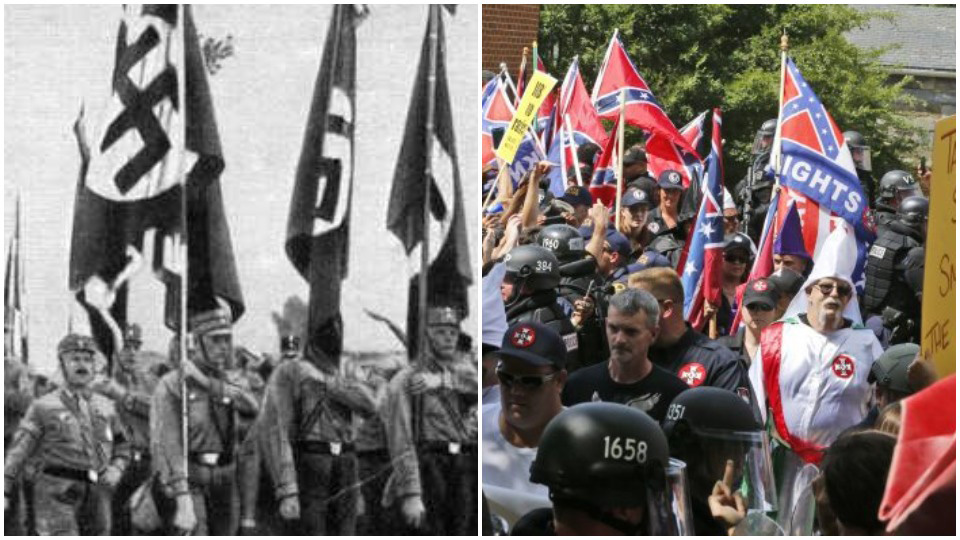
WASHINGTON—Neo-Nazis, including the one who fatally ran down counter-protester Heather Heyer with his car, were part of the infamous “alt-right” riot in Charlottesville, Va., last August. Now, a panel of historians says there are more parallels than people realize between the U.S. “alt-right” and its allies and the real Nazis—the ones led by Adolf Hitler in Germany from the 1920s to 1945.
Not only that, but Hitler’s Nazis used U.S. race laws—those creating Jim Crow, outlawing so-called “miscegenation,” establishing “Black Codes,” and encouraging the Ku Klux Klan—as a basis for their own racist legislation against Jews. Those infamous Nuremberg Laws, stripping Jews of citizenship and many ways to even make a living, preceded and foreshadowed the “Final Solution,” the genocide of six million European Jews in Nazi extermination camps during World War II.
Those were among the points made by a panel of historians on “Anti-Semitism and racism: Sources, similarities, and differences,” during the American Historical Association convention in D.C. on Jan. 6.
And the similarities are not just found in the U.S., either, the panelists said.
Professors Jeffrey Herf and Piotr Kosicki of the University of Maryland at College Park, James Whitman of Yale (whose paper was read because he was ill), Mirna Zakic of Ohio University, and moderator Aaron Rabenbach of Princeton all made the point that the equivalent of the alt-rightists in Western Europe also follow Nazi lines, with one occasional political exception.
Some of “the new rightists in Europe are clothing themselves in philo-Semitism,” said Rabenbach, admiring Israel’s current right-wing government and its anti-Arab policies, but for their own racist anti-Muslim reasons. Such sentiment is uncommon, Herf retorted. “The major themes of the far right are the myth of the Holocaust and, in Germany, the extortionist nature of the Israeli state,” he said.
Nevertheless, the panelists spent much of their time tracing parallels between the ideologies and rise of the alt-right in the U.S. and the ideologies accompanying the Nazis’ rise in Germany, along with the Nazis’ actions there when they took power.
“It’s a fair statement to say so many of us working on Nazi Germany and the Holocaust have not thought about the long-term shadow” that era casts, Herf said. “From a political point of view, I hope historians of American racism and Nazi anti-Semitism will find more common ground than they have in the past.”
They certainly found it in Charlottesville, the panel said. The alt-right, neo-Nazis, KKK, and their allies who rioted there, presumably defending a statue of Confederate General Robert E. Lee, not only killed Heyer—along with two state troopers whose helicopter crashed—but injured between 19 and 36 other people, including an African-American man severely beaten in a parking garage. And they did so while screaming vicious chants against minorities in general and Jews in particular.
The rioters also advocate repression of those minorities, and that’s where the parallels between the Black Codes and the Jim Crow laws of the U.S. and the Nazis’ Nuremberg Laws come in. In his paper, which Rabenbach read on his behalf, Yale’s Whitman described how a team of 35 Nazi jurists and lawyers traveled to the U.S. in the early 1930s to study and ask questions about the Jim Crow laws and similar legislation, not just in Southern states, but nationwide.
Those laws included statutes making “miscegenation”—intermarriage between the races—a felony and ensuring what Whitman, in an understatement, called “second-class citizenship for African-Americans, Native Americans, Filipinos, and Latin Americans.”
The Nazis also noticed the carnage of World War I left the U.S. as the world’s dominant economic power. Using their own ideology, they made the link to racism, Whitman’s paper added: “Hitler believed racism made America a rising world power, so it would also do so for Germany.”
But in another parallel with the rise of the “alt-right,” it wasn’t just the Nazis who believe that ideology, and it wasn’t just Jews who were targets of racists in pre-World War II Europe, the historians warned.
While Hitler and the Nazis called European Jews “enemies and parasites,” the pre-war Catholic primate of Poland—an intensely devout country 71 percent Catholic and 11 percent Jewish—alleged Jews “engaged in violence and white slavery,” one speaker said. Meanwhile, Protestant churches “promoted anti-Semitism.”
“But anti-Semitic rhetoric was also used against Slavs, Bolsheviks, and capitalists,” Rabenbach added. Another parallel based hatred on both exaggerated notions of Jewish power and Christian theology of Jews as Christ-killers. The Catholic Church did not abandon that theology worldwide until 1963.
“Neither the anti-Semitism nor the racism was based on color,” Whitman’s paper noted. And unlike the Jews, the others were not “believed to be engaged…in a dangerous political threat against Germany that had to be exterminated to save the nation.” The Jews were, and that led to Hitler’s “Final Solution.”
The historians also drew parallels between support for Hitler among German Junkers, aristocrats, industrialists, and the masses—all for their own reasons—and current U.S. neo-Nazis and other alt-rightists drawing everything from silent acquiescence to outright backing from segments of U.S. society. In particular, they focused on the reaction, or lack of it, to President Donald Trump’s statement that “good people” exist among the “alt-right,” neo-Nazi, and KKK rioters.

“My greatest fear is that we are living with the consequences” of the Nazis’ era of 1933-45 and the rise of the alt-right and their allies now, said Rabenbach. “The White House says ‘The people have spoken. There is no further truth to discuss.’” That echoes Nazi propaganda, he added.
Omitted from his summation: The Nazis won only one-third of the vote and one-third of the Reichstag’s 584 seats in the last free elections in Germany before they took power, and actually lost votes and 34 seats. Trump lost the U.S. popular vote to Democratic presidential nominee Hillary Clinton.
“There are truths that cannot be put to a vote,” Rabenbach stated. “That principle was abandoned in American race law and at the height of Nazi Germany. I fear we are at the cusp of this again.”










